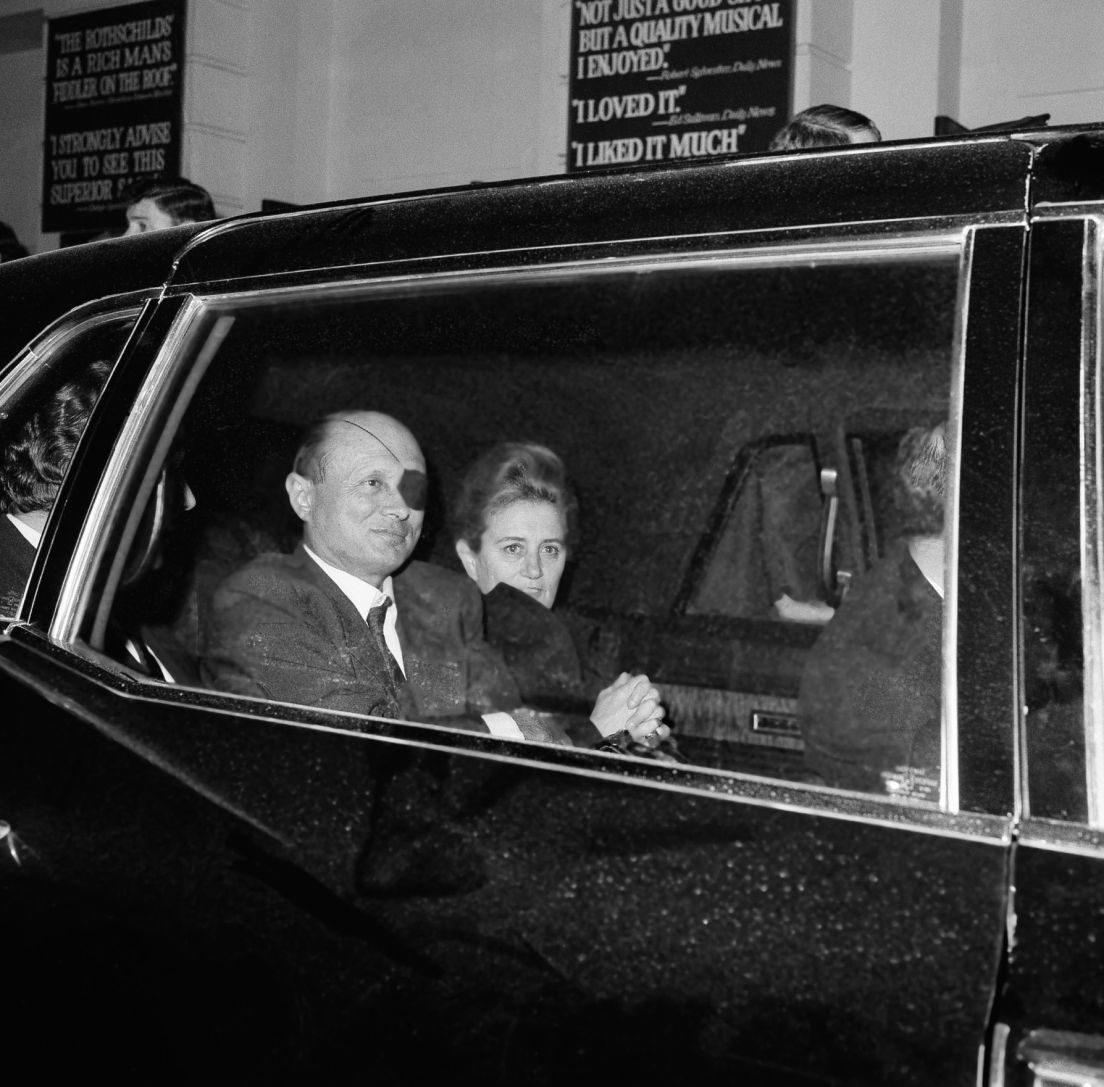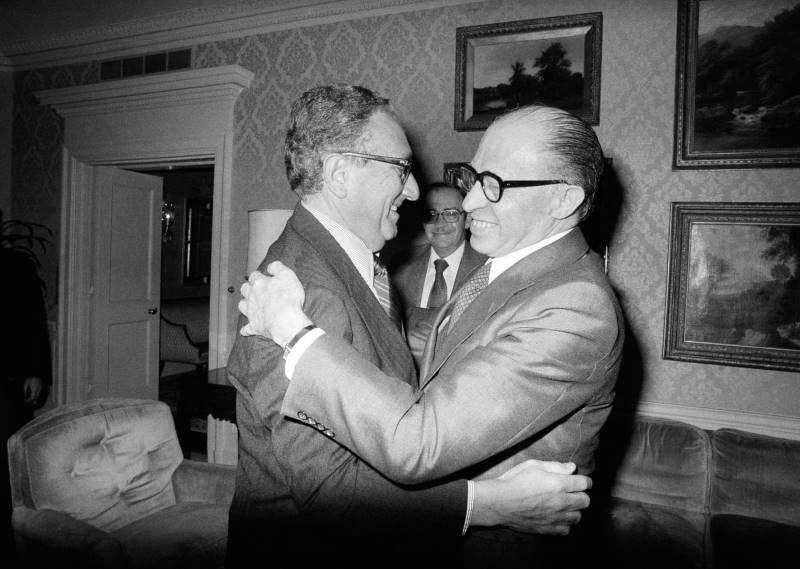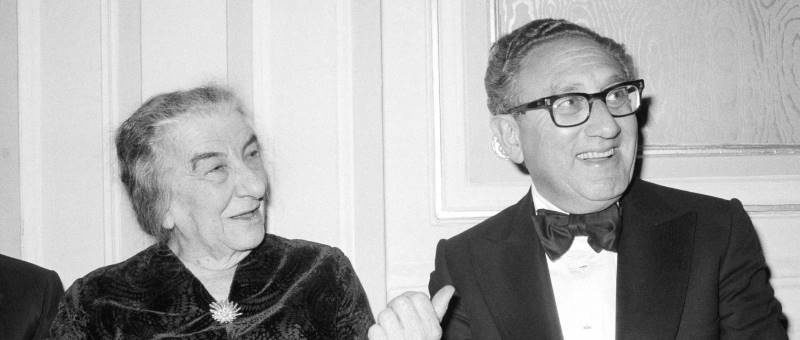According to a legend believed by the public and even in the government's security branches, the Americans know - or can know - everything about Israel. They eavesdrop, they photograph, they spy. They have agents at the top - in the government and the army. They have ears and listen; they have eyes and see. This is bad because it's hard to hide things from them. And this is good if we want to inform them of something indirectly, as a fact or a bluff.
How incorrect that feeling is, or at least, how untrue it was in the pre-computer era - because today the situation may be different - can be discovered from thousands of classified documents of the Central Intelligence Agency that are related to Israel and which, in recent weeks, have become accessible to anyone who is curious and bored.
Almost 1 million such papers, which include everything in the universe, were discovered in the seam between the administration of former U.S. President Barack Obama and new President Donald Trump.
Some of them were available previously, but reading them required reporting to the U.S. National Archives in a Washington suburb. Now the flood has arrived and everything is accessible. Most of the documents were produced by the CIA, but occasionally one finds among them rare copies of materials from the foreign and defense ministries or other intelligence agencies, which were transferred for perusal by the CIA and remained in the collection permanently. Not everything has been publicized, and even in what was publicized, there are paragraphs and even pages that were strongly censored, especially nuclear information.
But a survey of the materials - much more than a sampling, but still partial - reveals the big CIA-Israeli secret: they knew hardly any secrets. A lot of gossip, false ideas, an analysis of political and social trends on the level of open journalism, the Knesset cafeteria or embassy telegrams.

Following is a representative, concise selection of details from Israeli data held in the CIA collection. An additional article will be forthcoming at a later date.
Spring 1979: We didn't know how ill Golda was
At the end of the 1970s, the CIA department of medical information focused on analyzing the health of the Soviet leaders - first and foremost Leonid Brezhnev, but the next in line as well. There was good reason: Between 1982 and 1985, leaders Brezhnev, Yuri Andropov and Konstantin Chernenko died one after the other, leaving the arena clear for Mikhail Gorbachev. The physical and mental condition of the various leaders and the balance of power in the leadership had a decisive influence on the formulation of Soviet policy and U.S. security and world peace.
aa by Anonymous LJQKZD on Scribd
Medical intelligence, which included the Center for the Analysis of Personality and Political Behavior, was headed by a psychiatrist (whose recommendations to President Jimmy Carter prior to the Camp David Summit shaped the different handling of Israeli Prime Minister Menachem Begin and Egyptian President Anwar Sadat) and attempted to diagnose patients remotely, without their knowledge.
The findings: Mostly video footage (Heaviness of movement? Parkinson's?) and close-ups (Swelling in the face due to injections? Jaundice - or a problem with the color in the photo?) and, occasionally, reports from meetings. In addition to the Soviets, there was also surveillance of leaders such as Cuba's Fidel Castro and France's François Mitterrand.
The health of Menachem Begin greatly preoccupied the CIA. His illnesses - heart disease and diabetes - were well documented, including his hospitalizations. In the spring of 1979, on the eve of President Jimmy Carter's trip to the region and the signing of the Israeli-Palestinian peace treaty, the experts risked a positive forecast: Begin would survive. A word of caution was attached to the assessment, though: The Israeli government officially handed over all the information, but a degree of suspicion was required, maintained the CIA, in case the data are partial or misleading - particularly in light of the fact that it was only at the time of her death that the CIA discovered Prime Minister Golda Meir was battling lymphoma for over a dozen years. "We had absolutely no idea of her fatal illness," wrote the CIA.
Contributing to the concealment was Meir's ostensible openness when she was suffering from a different illness, shingles. In her meetings with U.S. Secretary of State Henry Kissinger, she spoke openly about the pain and discomfort - but not about the real reason for concern.
April 1959: The 'Ducks' mislead Washington
The so-called "Night of the Ducks" - the public mobilization exercise that embarrassed Israel on April 1, 1959, and led to the ousting of the heads of the army's Operations Directorate and Military Intelligence generals Meir Zorea and Yehoshafat Harkabi - caused tension in the entire region and concerned the Eisenhower administration, a few months after the coup against the pro-Western regime in Baghdad, the formation of the United Arab Republic by Egypt and Syria, and the landing of U.S. forces in Beirut.
Two hours after the broadcasting of the mobilization codes, the soldiers of the UAR's 1st Army were summoned to their units - in other words, the Syrian army. The CIA activated a "surveillance committee for the mobilization in Israel."
The CIA estimated that the Syrian call-up was a direct response to the Israeli call-up order. No preliminary means were observed in Israel, such as commandeering vehicles. There had been no unusual incidents on the borders, either, although there was Israeli-Egyptian tension on the issue of the cargo of ships in the service of Israel in the Suez Canal.
In descending order of probability, the surveillance committee proposed the following possible explanations: a mobilization exercise (the most likely); a demonstration of readiness for action as a pressure tactic; a real response to some unknown information about real or suspected changes along Israel's borders; preparations for a possible military action (the least likely).
Only one explanation was not offered - the real one. The entire broadcast, which aroused panic due to problems of coordination and briefing, was meant to serve as bait to the Egyptian air force, which would be sent to take photos in the Negev and would fall into an interception ambush by the Israel Air Force. The significance: The internal contacts in the IDF between IAF Commander Ezer Weizman and Chief of Staff Haim Laskov to generals Zorea and Harkabi were not registered by U.S. surveillance, with or without a committee.

On the eve of the first Lebanon war, six weeks after the conclusion of data collection and near the time of the completion of the evacuation of Sinai as part of the peace treaty with Egypt, the Middle East (or "Near East," as the administration called it) department in the CIA Research Administration published a survey on the subject of "Israel: The Sephardi-Ashkenazi Confrontation and its Implications."
Thus said the sages of the CIA 35 years ago:
"The dominance of Israel's government and economy by Ashkenazi Jews is largely attributable to their early sizable immigration to Palestine and their organization and leadership of all the major prestate public and private institutions.The experts ignored the contradiction between the last two paragraphs: political inflexibility was translated into defense budgets, at the expense of the welfare budgets.
"Heavy immigration to Israel by Sephardi Jews did not begin until after the state was founded in 1948. This fact and their traditional lifestyle put them at a considerable disadvantage. They continue to lag far behind the Ashkenazim in most major areas - income, university education and opportunities to advance to senior positions in government and business.
"Given their relatively high birthrate, the Sephardim will constitute a growing majority of Israel's electorate. Prime Minister Begin's Likud bloc must retain their overwhelming support if it is to remain in office. The opposition Labor Party has bleak prospects of returning to power unless it can project a more credible appeal to the Sephardim by ending endemic party infighting, assuming a tougher foreign policy stance and endorsing Sephardi demands that a greater percentage of the government budget be devoted to social programs."
"The election of 1981 clearly demonstrated that Israel is split along ethnic lines into a three-bloc political system: an intensely nationalistic, predominantly Sephardi working class supporting Likud; a more moderate, heavily Ashkenazi middle and upper class backing Labor; and a relatively evenly balanced group supporting the religious parties." The report added that in the 1981 election, 60 percent of Likud voters - but only a quarter of Labor voters - were Sephardim, despite the fact that among the MKs of the two parties only six of 48 in Likud were Sephardim, compared to 17 of 47 in Labor. Sephardi support for Likud "rested largely upon identification with Begin as a forceful, reliable leader." After his departure from the scene, Sephardi dissatisfaction with Likud's failure to address pressing domestic social and economic problems "could lead to serious alienation and an increase in Sephardi-led violence," it stated.
The pages of the survey are full of historical and political meditations. Among them is the claim that, due to the geographical distance from the main events of World War II, the Holocaust did not touch most Sephardi Jews and they were not sensitive to the Ashkenazi preoccupation with it; and that housing was especially problematic for the Sephardim. The poor neighborhoods of Sephardim remained in the big cities - Hatikva in Tel Aviv, and Musrara and Katamon Tet in Jerusalem; while Ashkenazim dominated prestigious neighborhoods like Savyon and Herzliya (Pituah).
The survey noted that Ashkenazim had an average advantage of three extra years study over Sephardim, and of the 250,000 Israelis above the age of 14 who didn't know how to read and write, two-thirds were Sephardim.
It was further noted that veteran Ashkenazim, many of whom had American families ties, would probably spur the Israeli government to consult with leaders of American Jewry on questions of Israeli foreign and domestic policy, but for most Sephardim - and many of the young people born in Israel - had no cultural contact with American Jews, nor any incentive to take their opinions into account.
CIA file on Moshe Dayan by Anonymous LJQKZD on Scribd
December 1970: Don't restrain Dayan
The restrained CIA analysts lost their cool when it came to Moshe Dayan. They fell in love with him when he was still chief of staff, even before the campaign in Sinai. They described him as tough and talented, were charmed by him, and quoted him as saying he would return fire by any means except a nuclear bomb, and would not necessarily limit himself to the area of the source of the fire. He would also tour every point of the Kinneret, at the time on the border with Syria, and no UN decision would prevent him from doing so.
When he was appointed defense minister in Levi Eshkol's government on the eve of the Six-Day War, the CIA adopted a custom: to assess that soon, or after the next election, Dayan would win the leadership of the Labor Party and be named the successor to Eshkol/Golda Meir. And although they correctly diagnosed his tied competition with Yigal Allon and anticipated the rise of a compromise candidate like Pinchas Sapir, the CIA found it difficult to conceal their bias toward Dayan.
In December 1970, about three months after the death of Egyptian President Gamal Abdel Nasser and the rise of Sadat - who prolonged the cease-fire in the Suez Canal - Dayan was about to arrive in Washington for talks. The CIA had a dilemma. On the one hand, there was nobody in the Israeli leadership who was as original and creative, open and blatant, as he - and he was even capable of completely changing his mind without regret or shame: just as one day he opposed the mediation of Swedish diplomat Gunnar Jarring until the Egyptians withdrew their ground-to-air missile batteries from the canal area, the next he could say the opposite and perhaps get the public behind him - but not necessarily his own party, which envied him.
The CIA wrote that in the three months preceding the cease-fire, 118 Israelis were killed, compared to 23 in the three months since then. They wrote that Dayan believed in talks with the Arabs from a position of strength. Personally, they wrote, he is generous and considerate of the Arabs as individuals, believes in permanent goals but flexible tactics adapted to changes in circumstances. Therefore, he felt what was said in September didn't have to dictate words and deeds in November-December - but that most other Israeli leaders found this disconcerting, and that the ministers would try to limit Dayan's room to maneuver in Washington.
They noted that his rivals were hoping for his downfall. Meir wouldn't be happy to see Dayan profiting politically from the praise showered on the person who would promote Israel's political standing. Their relations weren't warm, according to the CIA; they represented rival factions, but were dependent on one another.
July 1954: How peace with Jordan was prevented
To illustrate the difficulties in achieving an Israeli-Arab peace, one of the CIA documents, from July 1954 - without a source or verification - tells of something that ostensibly happened to King Abdullah I of Jordan (the grandfather of King Hussein), shortly before he was murdered in the summer of 1951. During one of his many meetings at the time with Israeli representatives, he was about to sign an agreement. Suddenly the pen slipped from his hand; it fell and bent. Seeing it as a bad omen, the king was deterred and didn't go back to sign.
October 1973: The flying camera landed too slowly
CIA pilots, along with their colleagues from the U.S. Air Force, secretly flew the U-2 espionage planes. Francis Gary Powers - who was brought down on May 1, 1960 and handed Russia's then-President Nikita Khrushchev a propaganda coup - was the first pilot to take off from the base in Turkey, and during the 1956 Sinai Campaign, the day after Battalion 890 was air-dropped into the Mitla Pass, flew over the skies of Lebanon, Jordan, Israel and finally Sinai, where he photographed the columns of smoke in the battles between the IDF and Egyptian army.
Two week earlier, there were sorties above Rhodes, Israel and Cyprus, to spot the French, British and Israeli preparations. The preparations were revealed, but not the intentions: U.S. Secretary of State John Foster Dulles, whose brother Allen was the head of the CIA, told President Eisenhower on the eve of the operation that Israel would attack Jordan, and then the British and French would exploit the commotion to take control of the Suez Canal.
The working assumption that "the Americans see everything" is far from the truth. Before the era of satellites (and, later, drones), the photographic sorties of the U-2 and SR-71 were rare and clumsy. Resources were devoted to collecting intelligence about the Soviets and Chinese. Allocating sorties to the Middle East required special organization. When the Soviets and Egyptians moved missiles to hideouts on the night of the War of Attrition cease-fire in August 1970, and Israel raised an outcry, it turned out there was nothing to compare it to - there were photos of the new situation, but nothing from beforehand.
And a CIA document from October 22, 1973 - the day of the first cease-fire in the Suez Canal during the Yom Kippur War - provided illuminating insights about the rate of the American photographic response; it was much slower than they had estimated in the area, and especially in Israel. The photo sorties operation began only on October 13 - the day after Golda Meir's decision (spurred by Chief of Staff David Elazar and IAF Commander Benny Peled) to accept a cease-fire when the Egyptian army was east of Suez and the IDF was still not to the west of it.
October 13 was also the day when U.S. President Richard Nixon decided to put an end to indecision in the administration and to send the airlift to Israel that in Kissinger's opinion saved it. There was no practical significance about any futile ideas being bandied about among the military and political leadership in Israel early on October 9, when, due to feelings of despair, some suggested removing all kind of doomsday weapons from their hiding places so the Americans would see and the Arabs would be scared. Kissinger and his deputy, Brent Scowcroft - in interviews published here on the 40th anniversary of the war - denied ever hearing about such a maneuver. In any case, they said, U.S. policy was not influenced by it.
Now it has been proven how right they were. Not only is there no mention of the October 9 crisis in the activity report of the CIA team throughout that month. And even if something had emerged from a hiding place and become visible, there was no flying camera there to record it. And even if they suspected its presence - it would have arrived only a day or two later.
Amir Oren is a senior correspondent and columnist for Haaretz and a member of the newspaper's editorial board. He writes about defense and military affairs, the government and international relations.




Reader Comments